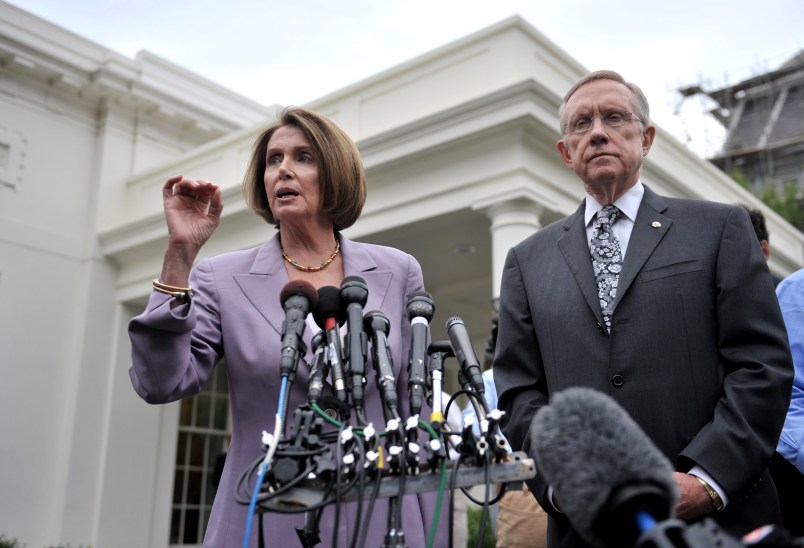After weeks of waiting and wondering, leaders in both chambers of Congress have announced their intentions with respect to the public option. House Speaker Nancy Pelosi is rounding up the votes for a bill with a government insurance plan that will negotiate rates with providers. Senate Majority Leader Harry Reid is standing behind something similar–with the addition of a clause allowing states to opt out–and is trying to keep his caucus together in the face of unanimous Republican opposition. But what about the rest of reform?
Right now, it’s impossible to compare what the Senate is trying to do with what the House is trying to do because Reid hasn’t unveiled his bill yet. But though there will surely be some major differences, both proposals will contain some of the same underlying architecture.
The basic theme of health care reform is that insurance would be mandatory, subsidized and regulated. As is the case today, for the first many years after enactment, most people in the country would be insured by their employers–in fact, large and medium-sized businesses would be required to provide insurance for their employees. Uninsured people would either be roped into existing entitlement programs like Medicaid, or required to buy regulated insurance–typically through an “exchange,” which, comprised of hundreds of thousands, or even millions, of customers, would theoretically have the bargaining power needed to keep premiums down.
For being handed a captive market, insurers would be faced with a new playing field: they’d be required to sell insurance to all comers, without using prior health conditions or gender as the basis for price discrimination. Though premiums would still vary based on things like age and geography, no two people of the same age in the same area would face the same serious price differentials they often see today. And both the House and the Senate would end the practice of “rescission”–canceling peoples’ policies or denying payment once they get sick.
Of course, poor and middle class people would still be on the hook for thousands of dollars a year worth of premiums, so the government would offer tax credits to people below a certain income to help them buy insurance–the lower your income, the greater your subsidy.
Though we can’t say for certain how the House and Senate plans will be at odds with one another, some of the key differences are likely to be a). the generosity of the subsidies, b). the way the subsidies and entitlement expansions are paid for, c). the stringency of the mandates, and d). the degree to which private insurers are regulated.
The House bill would give tax credits on a sliding scale to individuals and families living at or below 400 percent of the poverty line. If Reid hews to the bill passed by the Senate Finance Committee, the Senate would cap the subsidies at 300 percent of poverty. The House would expand Medicaid to cover everybody living under 150 percent of the poverty line. Reid’s bill would likely limit that expansion to 133 percent.
All these newly covered people will be benefiting from federal money, and that has to be raised from somewhere. Both chambers plan to extract billions (though in different ways and at different levels) from the health care industry, and from inefficiencies in Medicare. But to make up for the remaining billions, the House would impose a surtax on high-income earners. It’s unclear what the Senate will do, but the plan that passed the Finance Committee would impose an excise tax on high-end, employer provided insurance policies. This is controversial–unions don’t like it because the incidence of the tax could make all benefits more expensive, and industry doesn’t like it because it’s a tax on them. But by, in essence, taxing health care benefits, people would begin eschewing deluxe insurance policies in exchange for more modest policies and higher salaries. Likewise, as the cost of health care rises, more and more plans would be hit by the tax, raising more revenue over time and “bending the curve” of health care expenditures downward. In other words, wonks like it, but it’s extremely difficult politically.
The House’s employer and individual mandates would likely be stronger than the Senate’s. This would have the dual effect of a). raising more money for subsidies within the exchange, and b). covering more people.
Similarly, the House’s bill would make it harder for insurers to exploit loopholes in the new system. Its exchange would be nationwide, giving individuals in all states, big and small, equally impressive bargaining power with insurers. Insurers would be required to provide a fairly robust minimum benefit package, and those insurers that cover mostly healthy people would have to pitch in to help those insurers covering sicker-than-average consumers. And insurers would not be able to charge the elderly wildly more than the young. Though these details in the Senate bill are still being worked out, if they mimic the Finance Committee’s language, the exchanges will be state-based, resulting in diminished bargaining power–particularly for small states–and in regulations, imposed by states themselves, that could be significantly less stringent than the House’s federal standards would require. These, along with the subsidy provisions, are among the principle reasons reformers prefer the House bill.










